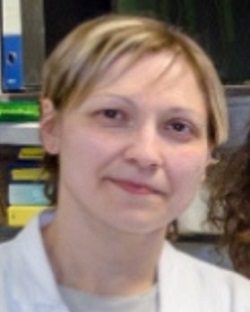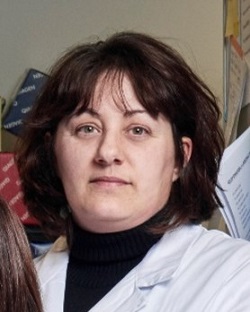
San Raffaele Telethon Institute for Gene Therapy
Gene transfer into stem cells

Gene therapy of genetic blood disorders relies on ex vivo molecular engineering of hematopoietic stem cells (HSCs) by adding a normal gene copy or correcting the mutated gene. This group’s work pioneered the use of viral vector-mediated gene transfer for the first gene therapy of human genetic diseases (ADA-SCID trial). The further development of lentiviral vectors with complex transcriptional regulation, together with proof-of concept efficacy and preclinical safety studies, led to the clinical translation of gene therapy for beta-thalassemia with a successful clinical trial in adult and pediatric patients. The composition and the status of the HSC population is a key determinant for the clinical outcome in gene therapy. In a back-to-the bench view, this unit focuses on HSC biology, HSC-niche interactions and molecular control of hematopoiesis and erythropoiesis in normal and stress conditions.
Research activity
Our research focuses on three main areas:
- Gene therapy for thalassemia. The clinical development of HSC LV-based gene therapy for transfusion-dependent ß-thalassemia was pursued along years in our lab, leading to the first trial. Clinical outcome showed a reduction of transfusion requirement in adult patients and transfusion independence in children. The group work is optimizing transduction protocols to improve the proportion of corrected cells necessary for complete correction of anemia and ineffective erythropoiesis. Moreover, the development of approaches of targeted biological conditioning will avoid toxicity of myeloablation while favoring the engraftment of genetically modified cells. Exploiting our long-lasting experience in the preclinical and clinical development of gene therapy, we also aim to test novel gene editing approaches.
- Defining the hematopoietic hierarchy in bone marrow stress conditions. To correct HSCs in disease context, it is important to gain mechanistic insight about when multipotency is lost and how lineage commitment is regulated normally and disrupted in stress conditions. Hematopoiesis is a continuous differentiation process and is maintained by distinct stem/progenitor cell populations in native and stress states, indicating that the hematopoietic hierarchy roadmap is flexible to adapt to different conditions. Our project is aimed to dissect molecular and cellular factors regulating the shape of hematopoiesis in erythropoietic diseases providing valuable clues to design therapeutic approaches combining genetic correction with restoration of erythroid maturation allowing a full rescue of disease hallmarks.
- Interactions of HSCs and their bone marrow niche components. This group provided the original demonstration that the bone marrow microenvironment in ß-thalassemia is perturbed, in terms of cellular and molecular components This stress environment could have an impact on the lineage commitment of HSCs leading to a unique model of hematopoiesis. Our aim is to identify the source of molecular stress signals in thalassemic bone marrow and key molecules and pathways causing HSC and niche dysfunction for the development of strategies to rescue normal bone marrow homeostasis and to improve gene therapy outcome, by exploiting combined strategies based on novel insight of HSC-niche biology.
Hardouin G., Panagiotis A., Martinucci P., Tristan F., Manceau S., Laure J., Masson C., Scaramuzza S., Ferrari G., Cavazzana M. and Miccio A (2022). Adenine base editor-mediated correction of the common and severe 2 IVS1-110 (G>A) β-thalassemia mutation. Blood. 2022 Dec 12:blood.2022016629. doi: 10.1182/blood.2022016629. PMID: 36508706
Aprile A., Sighinolfi S., Raggi L. and Ferrari G. (2022). Targeting the Hematopoietic Stem Cell Niche in Thalassemia and Sickle Cell Disease. Pharmaceuticals 15(5), 592.
Aprile A, Raggi L, Bolamperti S, Villa I, Storto M, Morello G, Marktel S, Tripodo C, Cappellini MD, Motta I, Rubinacci A, Ferrari G. Inhibition of FGF23 is a therapeutic strategy to target hematopoietic stem cell niche defects in β-thalassemia Sci Transl Med. 2023 May 31;15(698):eabq3679. doi: 10.1126/scitranslmed.abq3679. Epub 2023 May 31.
Ferrari G., Thrasher A.J. and Aiuti A. (2021). Gene therapy using haematopoietic stem and progenitor cells. Nat. Rev. Genet. Apr; 22(4):216-234.
Aprile A., Gulino A., Storto M., Villa I., Beretta S., Merelli I., Rubinacci A, Ponzoni M., Marktel S., Tripodo C., Lidonnici MR. and Ferrari G. (2020). Hematopoietic stem cell function in β-thalassemia is impaired and is rescued by targeting the bone marrow niche. Blood 136(5):610-622.Commentary in: Carlesso N. Blood 136, 529:531.
Crippa S., Rossella V., Aprile A., Silvestri L., Rivis S., Scaramuzza S., Pirroni S., Avanzini MA., Basso-Ricci L., Hernandez RJ., Zecca M., Marktel S., Ciceri F., Aiuti A., Ferrari G. and Bernardo ME. (2019). Bone marrow stromal cells from β-thalassemia patients have impaired hematopoietic supportive capacity. J Clin Invest. Feb 25;130. pii: 123191. doi: 10.1172/JCI123191.
Marktel S., Scaramuzza S., Cicalese MP., Giglio F., Galimberti S., Lidonnici MR., Calbi V., Assanelli A., Bernardo ME., Rossi C., Calabria A., Milani R., Gattillo S., Benedicenti F., Spinozzi G., Aprile A., Bergami A., Casiraghi M., Consiglieri G., Masera N., D'Angelo E., Mirra N., Origa R., Tartaglione I., Perrotta S., Winter R, Coppola M, Viarengo G, Santoleri L, Graziadei G, Gabaldo M, Valsecchi MG., Montini E., Naldini L., Cappellini MD., Ciceri F., Aiuti A. and Ferrari G. (2019). Intrabone hematopoietic stem cell gene therapy for adult and pediatric patients affected by transfusion-dependent ß-thalassemia.Nat Med. Feb;25(2):234-241.
Lidonnici MR, Aprile A, Frittoli MC, Mandelli G, Paleari Y, Spinelli A, Gentner B, Zambelli M, Parisi C, Bellio L, Cassinerio E, Zanaboni L, Cappellini MD, Ciceri F, Marktel S, Ferrari G. Plerixafor and G-CSF combination mobilizes hematopoietic stem and progenitors cells with a distinct transcriptional profile and a reduced in vivo homing capacity compared to Plerixafor alone. Haematologica 2017; 102(4):e120-e124.
Moiani A, Paleari Y, Sartori D, Mezzadra R, Miccio A, Cattoglio C, Cocchiarella F, Lidonnici MR, Ferrari G*, Mavilio F*. Lentiviral vector integration in the human genome induces alternative splicing and generates aberrant transcripts. J Clin Invest. 2012 May; 122(5):1653-66. (* Corresponding authors)
Roselli EA, Mezzadra R, Frittoli MC, Maruggi G, Biral E, Mavilio F, Mastropietro F, Amato A, Tonon G, Refaldi C, Cappellini MD, Andreani M, Lucarelli G, Roncarolo MG, Marktel S, Ferrari G. Correction of ß- thalassemia major by gene transfer in hematopoietic progenitors of pediatric patients. EMBO Mol Med. 2010; 2:315-328.







